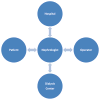Urgent-start peritoneal dialysis: a chance for a new beginning
- PMID: 24246221
- PMCID: PMC4124939
- DOI: 10.1053/j.ajkd.2013.09.018
Urgent-start peritoneal dialysis: a chance for a new beginning
Abstract
Peritoneal dialysis (PD) remains greatly underutilized in the United States despite the widespread preference of home modalities among nephrologists and patients. A hemodialysis-centric model of end-stage renal disease care has perpetuated for decades due to a complex set of factors, including late end-stage renal disease referrals and patients who present to the hospital requiring urgent renal replacement therapy. In such situations, PD rarely is a consideration and patients are dialyzed through a central venous catheter, a practice associated with high infection and mortality rates. Recently, the term urgent-start PD has gained momentum across the nephrology community and has begun to change this status quo. It allows for expedited placement of a PD catheter and initiation of PD therapy within days. Several published case reports, abstracts, and poster presentations at national meetings have documented the initial success of urgent-start PD programs. From a wide experiential base, we discuss the multifaceted issues related to urgent-start PD implementation, methods to overcome barriers to therapy, and the potential impact of this technique to change the existing dialysis paradigm.
Keywords: Peritoneal dialysis; acute peritoneal dialysis; acute-start peritoneal dialysis; late end-stage renal disease (ESRD) referral; urgent peritoneal dialysis; urgent-start peritoneal dialysis.
Copyright © 2014 National Kidney Foundation, Inc. Published by Elsevier Inc. All rights reserved.
Figures
References
-
- Golper TA, Saxena AB, Piraino B, et al. Systematic barriers to the effective delivery of home dialysis in the United States: a report from the Public Policy/Advocacy Committee of the North American Chapter of the International Society for Peritoneal Dialysis. Am J Kidney Dis. 2011;58(6):879–885. - PubMed
-
- Jiwakanon S, Chiu YW, Kalantar-Zadeh K, Mehrotra R. Peritoneal dialysis: an underutilized modality. Curr Opin Nephrol Hypertens. 2010;19(6):573–577. - PubMed
-
- Tam P. Peritoneal dialysis and preservation of residual renal function. Perit Dial Int. 2009;2(suppl 2):S108–S110. - PubMed
-
- Moist LM, Port FK, Orzol SM, et al. Predictors of loss of residual renal function among new dialysis patients. J Am Soc Nephrol. 2000;11(3):556–564. - PubMed
-
- Blagg CR. Dialysis composite rate bundling: potential effects on the utilization of home hemodialysis, daily and nocturnal hemodialysis, and peritoneal dialysis. Semin Dial. 2011;24(6):674–677. - PubMed
Publication types
MeSH terms
Grants and funding
LinkOut - more resources
Full Text Sources
Other Literature Sources
Medical


